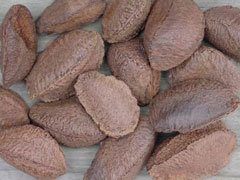


Home
Flowers &
Indoor Plants
Fruits & Nuts
Ornamentals
Vegetables
Special Topics
Resources
Glossary

|
Brazil Nut Bertholletia excelsa (bert-oll-e-shee-ah eck-sell-sah)  Click on thumbnails for larger image. |
 |
What about it? The Brazil nut is a large tree that grows wild in the Amazon forest of South America. Its large leaves are up to a foot long, and the flowers are pale yellow. The edible Brazil "nut" is actually the seed of the fruit. The fruit is about 6 inches in diameter with a thick outer shell. There are one to two dozen seeds, or nuts, inside these fruits, which take over a year to ripen. What is it used for?These tasty, rich nuts are enjoyed out-of-hand, although you have to work to get them; they require a nutcracker to break through the thick shell. The nuts are very oily, and the Native Americans of the Amazon region use these nuts for oil and as food. Where does it grow? How do we grow it? The Brazil nut tree needs warm temperatures, moisture, and moderate amounts of sunlight that imitate its native tropical environment. What are its primary problems? Brazil nuts have no exceptional problems. How do we harvest and store it? The fruit of the Brazil nut tree takes over a year to ripen. When ripe, the fruit must be "shucked" and the seeds (nuts) set out to dry. These should be stored in a cool, dry place.
© Copyright, Department of Horticulture, Cornell University. |